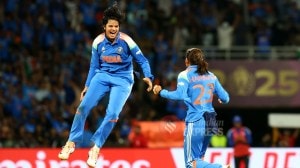Mystery of a Woman
THE noble wife of a legendary anti-hero. A misunderstood demoness who longs for love. And an Earth Goddess who steps in to save a woman’...

THE noble wife of a legendary anti-hero. A misunderstood demoness who longs for love. And an Earth Goddess who steps in to save a woman’s honour. The theatrical tradition may be 1,800 years old, but the readings couldn’t be more contemporary. And Kutiyattam exponent, Thrissur-based Usha Nangiar, is determined to revive the long-buried aspects of this form. At Prithvi Theatre’s recent national festival, she premiered episodes involving women characters with a strong presence, which have “not been seen in living memory”—Mandodari’s Nirvahanam, Lalitha’s Nirvahanam and Karthyayani’s Purappadu.
The initiative began two years ago, when Mumbai-based cultural organisation Keli backed the efforts of this Ammanoor Madhava Chakiar disciple. “These areas were on the brink of extinction. And when contemporary artistes explore this, a new richness of possibility emerges,” explains Keli secretary Ramachandran K.
As Kutiyattam was usually dominated by the Chakiar community (who performed the male roles), the Nangiars (women performers) fell into decline, between the 14th and 20th centuries, when patronage fell. So much so, today, many myths prevail about female characters. Like the belief that the Panchakanyas—including the main heroines of Mahabharata and Ramayana: Draupadi, Sita and Mandodari—couldn’t come on stage.
As for Lalitha—Shurpanaka’s beauteous guise—it was interpretation that intrigued her. “I’m not interested in Sita, who’s all about purity. Many see Lalitha as a cunning, lust-filled demoness. But I disagree. She was seeking a good husband, who could love her. Falling in love with Rama, she changed each aspect of her appearance to suit him. But the two brothers just send her back and forth between them,” she asserts, about this tale of a wronged woman.
But what thrills Nangiar most is her presentation of the Goddess Karthyayani, who helps Arjuna introduce Subhadra to his first wife, Draupadi. She’s the only Sanskrit-speaking female character in Kutiyattam (rather than Malayalam or Prakrit). And unlike the otherwise uniform make-up and costume, hers resembles the male’s. “Her voice and manner of speaking stand out too. Besides, there are very few divine characters in Kutiyattam. They ritualistically appear from the temple and only then enter the green room. I was lucky to find a leaf from a manuscript that specifies this for Karthyayani too. At one point, Arjuna even bows for her blessings, which has never been seen by a male character,” she elaborates, adding, “Such roles cannot be ‘played’, you have to live them.”
Nangiar and Keli have also brought out a book, Abhinethri, recording this process. “As it becomes more difficult to access the ancient texts, there was an explicit need for documentation,” explains Ramachandran about the book, which incorporates Nangiar’s research papers on Kutiyattam acting techniques and acting manuals on women characters. This success has led to their collaborating on another project, aiming at a complete documentation of Kerala’s independent rhythm culture.
Keli considers the premieres as gifts to Prithvi Theatre, on its 25th anniversary. And the standing ovations received have encouraged plans to travel with the recitals, beginning in Kerala.
As for Nangiar—determined “to unravel the mysteries surrounding women characters and the powerful dramatic situations involving them, now on the verge of disappearance”—her quest continues.


- 01
- 02
- 03
- 04
- 05





























